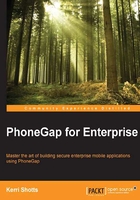
What this book covers
Chapter 1, PhoneGap and Enterprise Mobility, discusses the history of Apache Cordova/Adobe PhoneGap applications, presents reasons why Cordova/PhoneGap is a good fit for the enterprise, and how Cordova facilitates cross-platform development for Cordova and hybrid application architecture.
Chapter 2, Building the Data Store and Business Logic, introduces you to the typical backend server architecture, as well as designing the data models and business logic. You will also get introduced to Tasker, the demonstration app for this book.
Chapter 3, Securing PhoneGap Apps, shows the importance of ensuring the security of enterprise data. This chapter also covers backend security, general security, and issues that relate directly to Cordova/PhoneGap apps.
Chapter 4, Building the Middle Tier, discusses RESTful-like APIs and HATEOAS (Hypertext As The Engine Of Application State). A sample Node.js server is included as a demonstration of these topics, including examples of connecting to databases, executing queries, and generating appropriate responses.
Chapter 5, Communicating Between Mobile and the Middle Tier, demonstrates how to ultilize XMLHttpRequest (XHR), SSL Certificate fingerprints, and third-party Cordova/PhoneGap plugins in order to facilitate secure communication between the mobile application and the backend servers.
Chapter 6, Application Events and Storage, briefly discusses how to respond to changes in network events and application state. This chapter also introduces a third-party SQLite plugin for persistent data storage and an additional plugin to access the iOS Keychain for secure data storage.
Chapter 7, Push Notifications, covers typical Push Notification architecture, and introduces you to Boxcar.io, a service that provides an HTTP API to send pushes. It also introduces a PhoneGap API to respond to these push notifications.
Chapter 8, Building the Presentation Tier, covers many of the different patterns used to build a mobile application, including mock-up tools, various libraries and frameworks, common patterns (MVC, data binding, templates, and so on), forms and validation, and data visualization.
Appendix, Useful Resources, provides web links to resources that the reader might find useful for further learning. These are split chapterwise so that they can relate to a specific chapter in this book.